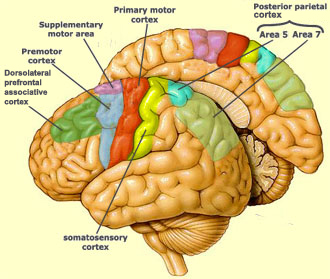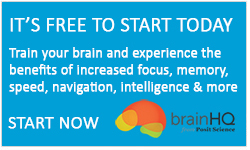Fun Facts About the Brain

Babies Lose Half their Neurons at Birth
It is estimated that a baby loses about half their neurons before they are born. This process is sometimes referred to as pruning and may eliminate neurons that do not receive sufficient input from other neurons.
Baby Talk Increases Vocabulary
A study showed that when mothers frequently spoke to their infants, their children learned about 300 more words by age two than did children whose mothers rarely spoke to them.
Birdsong Similar to Human Speech
Birdsong and human speech have similar characteristics. Birds, like humans, learn their complex vocalizations early in life and imitate their adult counterparts to acquire these skills. These two species have evolved a complex hierarchy of specialized forebrain areas where motor and auditory areas interact continuously in order to produce detailed vocalizations.
Blind Spot In Eye
The optic nerve exits the retina as a single bundle. The exit point within the retina has no receptor cells. This location forms a blind spot in each eye. We rarely notice these spots because they do not overlap within the image formed by the two eyes. Your ophthalmologist can only detect your blind spots by having you close the eye not being tested.
Brain Measurements Are Revealing
Electroencephalogram, or EEG, is a non-invasive technique used to record small changes of electrical activity in the brain with surface electrodes on the scalp. Scientists who study sleep find EEG especially useful. The tiny fluctuations detected with EEG are clear indicators of whether a person is asleep, aroused, or somewhere in between.
Brain Uses 20% of Blood
Approximately 20% of the blood flowing from the heart is pumped to the brain. The brain needs constant blood flow in order to keep up with the heavy metabolic demands of the neurons. Brain imaging techniques such as functional magnetic resonance imaging (fMRI) rely on this relationship between neural activity and blood flow to produce images of deduced brain activity.
Brain Uses 20% of Oxygen Breathed
Although the brain accounts for only 2% of the whole body's mass, it uses 20% of all the oxygen we breathe. A continuous supply of oxygen is necessary for survival. A loss of oxygen for 10 minutes can result in significant neural damage.
Child Brain Development
Measures of brain activity show that during the second half of a child's first year, the prefrontal cortex, the seat of forethought and logic, forms synapses at such a rate that it consumes twice as much energy as an adult brain. That furious pace continues for the child's first decade of life.
Dividing the Hemispheres
Commisurotomy, the transection of the corpus callosum, is one possible treatment for patients with severe epilepsy. This procedure causes a complete split between the two hemispheres of the brain. As a result of this split, words presented to the patient's far left visual field cannot be read (alexia), and hidden objects placed into the left hand cannot be named (anomia). This is significant evidence for hemispheric specialization.
Early Brain Growth
During the first month of life, the number of connections or synapses, dramatically increases from 50 trillion to 1 quadrillion. If an infant's body grew at a comparable rate, his weight would increase from 8.5 pounds at birth to 170 pounds at one month old.
Ears Emit Sound
Did you know that healthy ears actually emit sounds? These sounds are usually very soft, but can occasionally be heard by others. Surprisingly, the sounds are rarely heard by the person whose ear is emitting the sounds! The cause of these sounds is still under debate, but is thought by some to be due to input from the central nervous system.
Elongated Eye Causes Nearsightedness
Nearsightedness (myopia) is the most common visual problem we experience. It is the result of an overly elongated eye, which has become specialized for seeing near objects extremely well.
Even Reptiles Yawn
Yawning is an age-old activity that occurs in reptiles, birds and, of course, mammals. This behavior is controlled by chemicals in the brain called neurotransmitters. Neurotransmitters, such as nitric oxide and dopamine, act in the hypothalamus to induce and control yawning.
Eyes See Inside Out
The light-detecting receptor cells within the retina, called rods and cones, are actually at the back of the retina under several layers of cells. The neurons and support cells within the retina are fairly translucent, so light is able to pass through them and reach the receptors.
Image Goes Back and Forth Across Retina
Because receptors (rods and cones) are at the back of the retina, an image actually passes through the retina three times: as light to the receptor cells (back); as neural signals through the initial visual processing of the retina (forward); as neural signals via the optic nerve to the brain (back again).
The "Little Brain"
The human cerebellum, or "little brain", weighs about 150 grams. Located at the lower back of the brain, the cerebellum is key to maintaining posture, walking, and performing coordinated movements. It is also thought to play a role in olfaction or smell.
Looking Through a Small Hole
Nearsighted people can often read the lettering on distant signs by looking through a small hole with one eye. The hole focuses the light entering the eye and replaces the function of the eye's own lens.
Miles and Miles of Neurons
There are one hundred billion neurons in the brain. A stack of one hundred billion pieces of paper would be about 5000 miles high, the distance from San Francisco to London.
Nasal Neurons Regenerate
Olfactory receptor cells, the neurons in our nose that allow us to smell, are neurons that can regenerate throughout life. Although these cells are continually being born and dying, they maintain the same connections as their ancestors. The result is that once we learn a smell, it always smells the same to us—despite the fact that there are always new neurons smelling it!
Newborns Distinguish Speech
Children as young as four days old can distinguish the vowel sounds of the language in their natural environment from those of a foreign language.
No Octopus Blind Spot
The octopus has a single layer of cells in the back of its eye. These receptor cells project directly back to the brain via the optic nerve. Because the optic nerve forms behind the receptors rather than passing through them, the octopus has no blind spot.
No Pain in Brain
There is no sense of pain within the brain itself. This fact allows neurosurgeons to probe areas of the brain while the patient is awake. Feedback from the patient during these probes is useful for identifying important regions, such as those for speech, that are spared if possible.
Peripheral Night Vision
At night, our peripheral vision is better than our foveal (straight on) vision. Hikers at night do better when they look slightly above the trail, and airplane pilots are taught to look for traffic out of the sides of their eyes. This is because our rod cells, photoreceptors that respond best to dim light, are located mostly in the periphery of the retina.
Pupillary Light Reflex
The pupillary light reflex results when light is shined into either eye causing both pupils to constrict. Doctors use this reflex to determine if the reflex pathway through the midbrain has in any way been disrupted. If the reflex fails to produce a response in one or both eyes, the doctor can deduce the location of the malfunction based on which of the eyes failed to respond and which eye was stimulated.
Reading Aloud Stimulates Child Development
Reading aloud to children helps stimulate brain development, yet only 50% of infants and toddlers are routinely read to by their parents.
Seizures Not Limited to Epilepsy
0.5% of the general population has epilepsy. But it is estimated that one in 20 people will have at least one seizure during the course of their life. While seizures are characteristic of epilepsy, having a single seizure does not, in itself, constitute epilepsy. The effects of seizures can vary from complete loss of consciousness to mild shakes or loss of balance.
When Eating is Tearful
The expression "crying crocodile tears" means expressing insincere grief. It arose because crocodiles appear to weep while they are happily munching on prey. A neurological disorder in humans called crocodile tears results from damage to the fifth cranial nerve, which controls the mucous membranes of the face. When the affected person is eating, signals that should stimulate salivation instead stimulate lacrimation--better known as crying.
Why We Scratch an Itch
Scratching an itch is a puzzling biological response, because it seems to hinder rather than help a wound's healing. One theory of why we itch suggests that scratching stimulates the release of endorphins, naturally occurring opiates which block pain sensation. Because scratching injures our skin a little more, we release a flood of endorphins to block the pain of the initial injury more effectively.
Working Memory Stores Seven Digits
It's no accident that telephone numbers in the United States are seven digits long. Our working memory, a very short-term form of memory which stores ideas just long enough for us to understand them, can hold on average a maximum of seven digits. This allows you to look up a phone number and remember it just long enough to dial.
Learn More Below
- About Our Brain Fitness Excercises
- Memory Grid
- To-Do List Training
- Syllable Stacks
- Scene Crasher
- Divided Attention
- Double Decision
- Mixed Signals
- Target Tracker
- Freeze Frame
- Eye for Detail
- Fine Tuning
- Hawk Eye
- Sound Sweeps
- Visual Sweeps
- Face to Face
- In the Know
- Recognition
- Face Facts
- Auditory Ace
- Card Shark
- Juggle Factor
- Mental Map
- Optic Flow
- Right Turn
- True North
- Mind Bender
- Rhythm Recall
- Hear Hear
- Mind's Eye
- Divided Attention
- Target Tracker
- Hawk Eye
- Visual Sweeps
- BrainHQ Exercise Tutorials
- Freeze Frame Tutorial
- Target Tracker Tutorial
- Mixed Signals Tutorial
- Sound Sweeps Tutorial
- Fine Tuning Tutorial
- In The Know Tutorial
- Divided Attention Tutorial
- Memory Grid Tutorial
- Syllable Stacks Tutorial
- To-do List Training Tutorial
- Auditory Ace Tutorial
- Hear Hear Tutorial
- Rhythm Recall Tutorial
- Double Decision Tutorial
- Hawk Eye Tutorial
- Visual Sweeps Tutorial
- Eye for Detail Tutorial
- Scene Crasher Tutorial
- Card Shark Tutorial
- Face Facts Tutorial
- Face to Face Tutorial
- Juggle Factor Tutorial
- Mental Map Tutorial
- Mind Bender Tutorial
- Mind’s Eye Tutorial
- Optic Flow Tutorial
- Recognition Tutorial
- Right Turn Tutorial
- True North Tutorial
- Double Decision Exercise Demo
- BrainHQ Level-Training
- Unique Benefits of BrainHQ
- World Class Science
- I Want to Challenge My Attention
- I Want to Challenge My Memory
- I Want to Challenge My Brain Speed
- I Want to Challenge My Navigation
- I Want to Challenge My People Skills
- I Want to Challenge My Intelligence
- Your Custom Designed Brain Training Program
- Studies & Clinical Trials
- Partners
- What BrainHQ Customers Say
- Coming Soon
- World Class Science
- Useful Links






 English
English
 Français
Français


